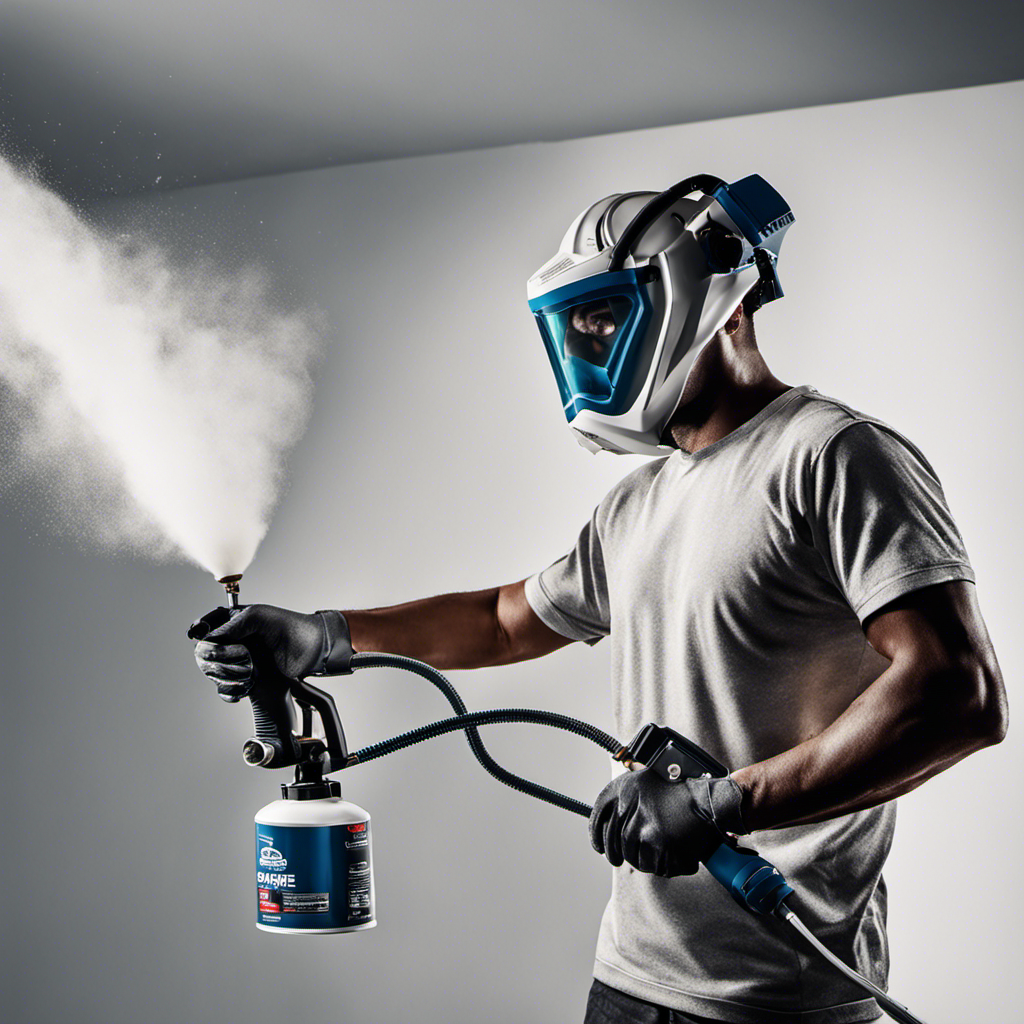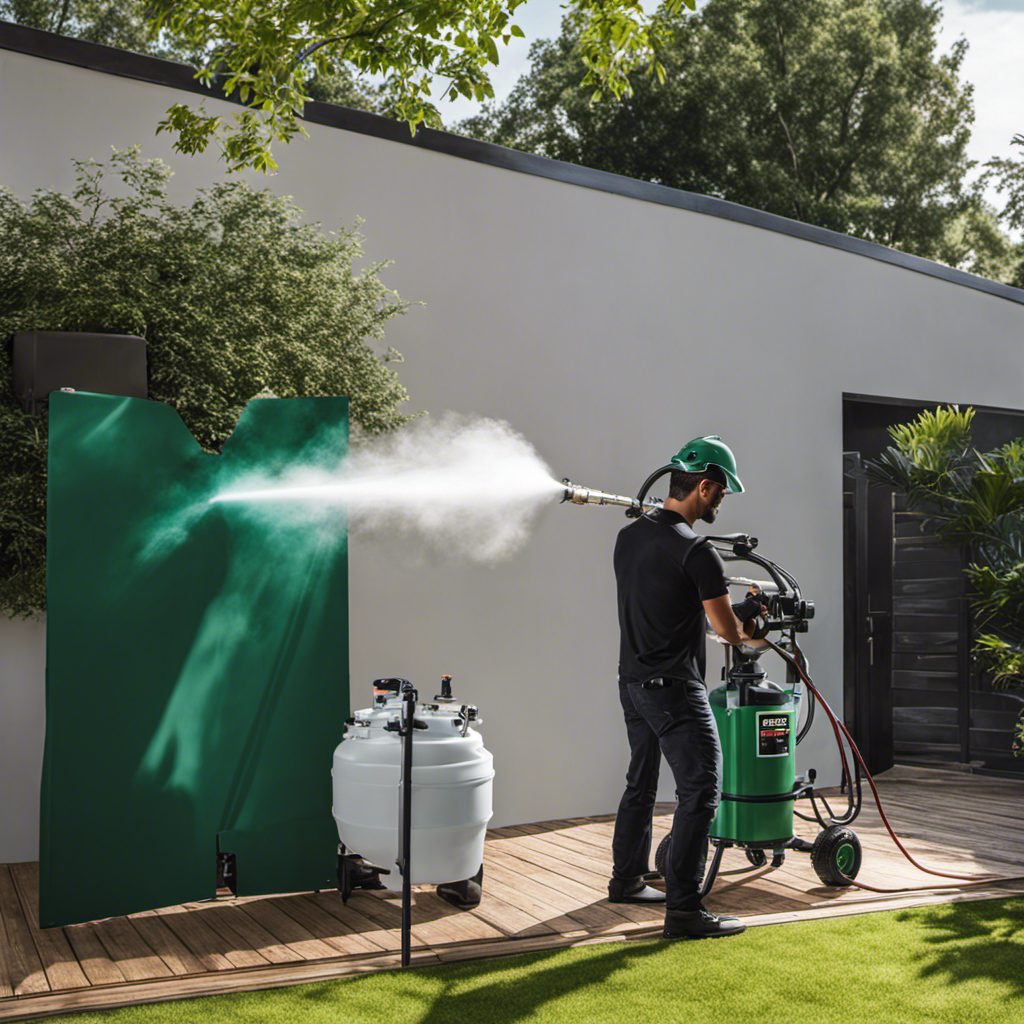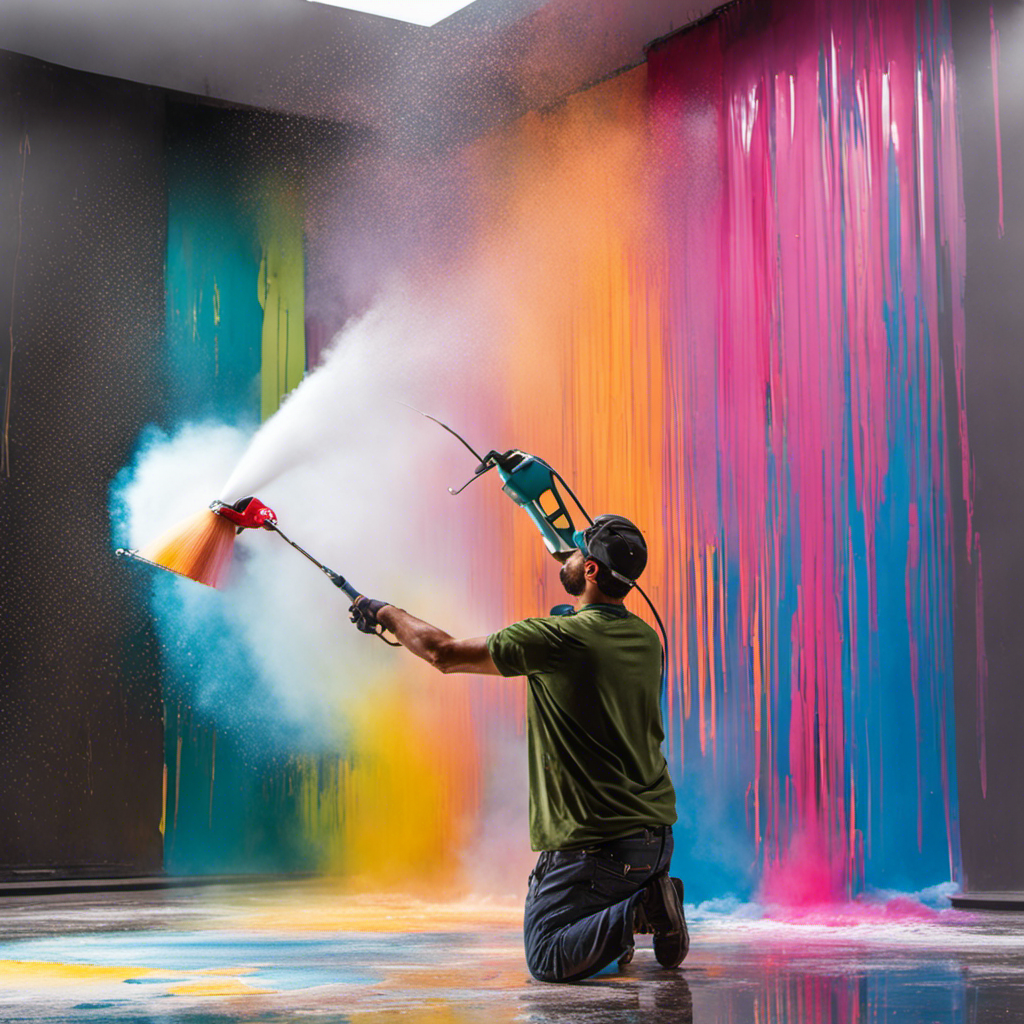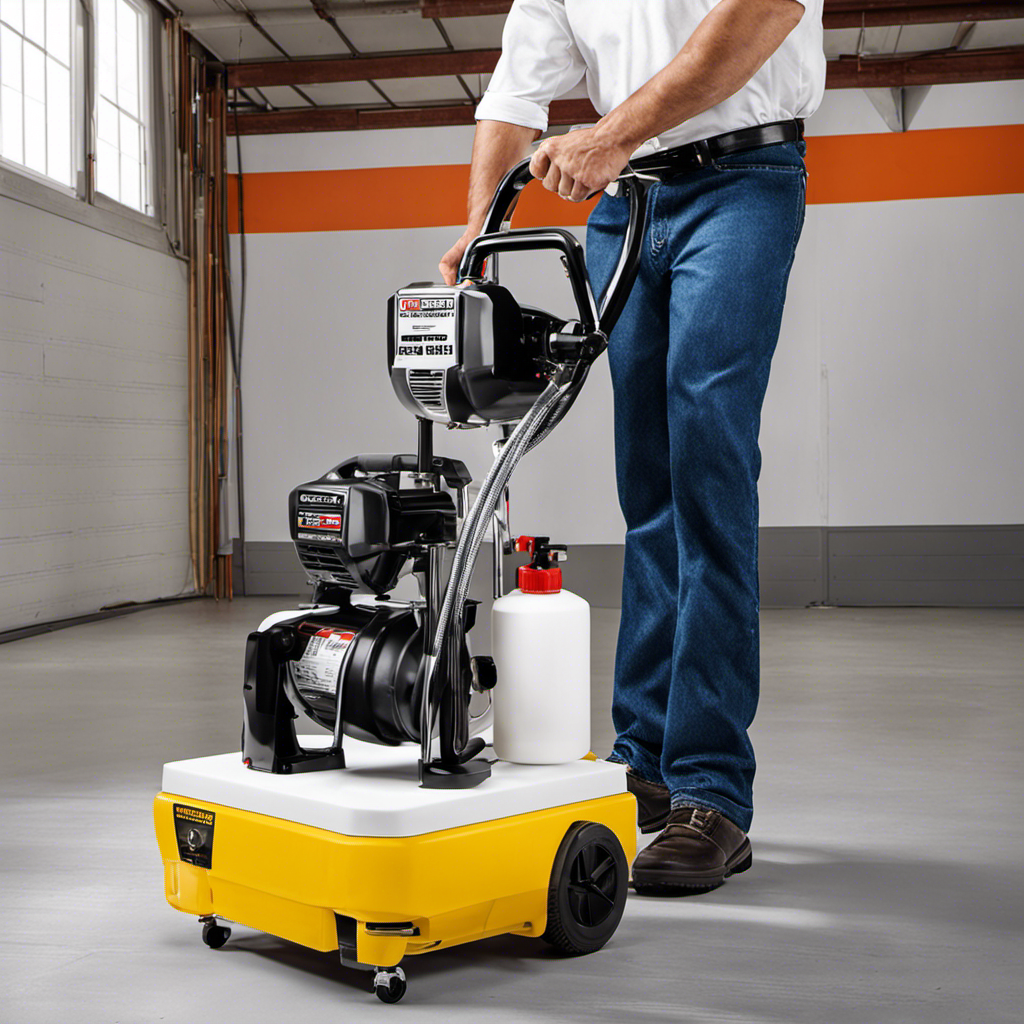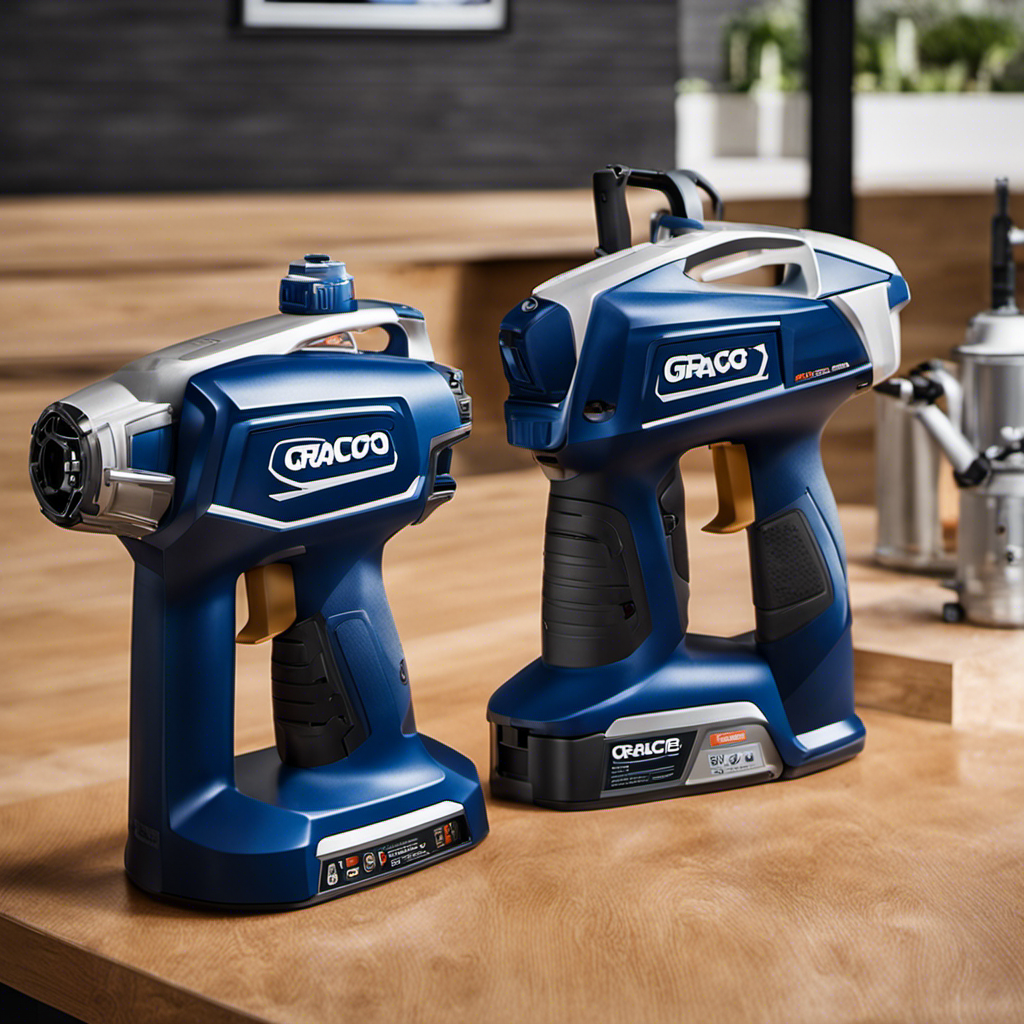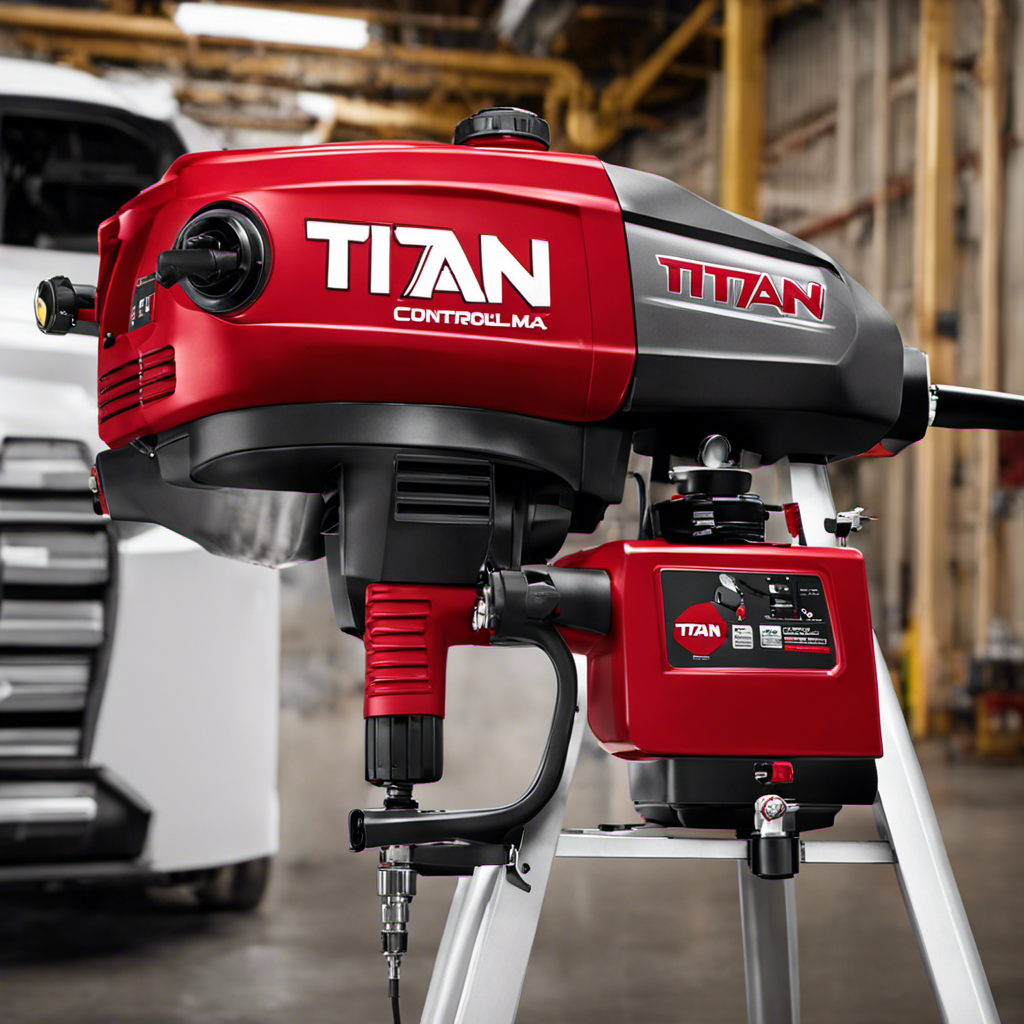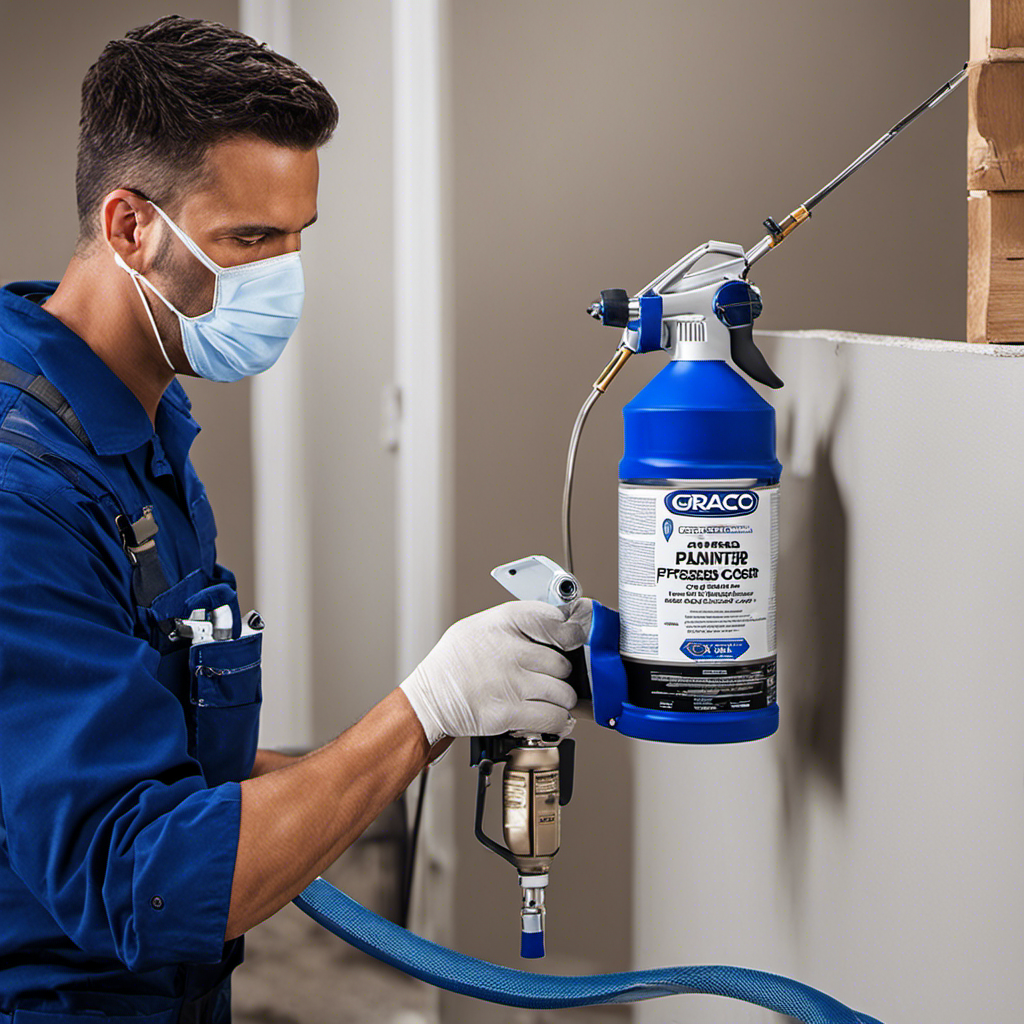Are you seeking to update your ceilings with a new paint job? Your search ends here! Discover a plethora of professional tips and strategies for painting ceilings with an airless sprayer in this article.
From maintaining a steady pace and distance to working in a systematic pattern, you’ll learn everything you need to know to achieve flawless results.
So, get ready to transform your space and create a stunning look that will leave everyone in awe.
Let’s dive in!
Key Takeaways
- Maintain a steady pace and hold the sprayer at a consistent distance from the ceiling.
- Work in a systematic pattern, avoiding overlapping strokes and adjusting the pressure for uneven surfaces.
- Use a brush or roller for touch-ups and assess coverage and color after the first coat.
- Allow each coat to dry thoroughly and give the paint 24 hours to fully cure, avoiding rushing the drying process.
Maintaining a Steady Pace and Distance
The painter should maintain a steady pace and hold the sprayer at a consistent distance from the ceiling to achieve an even coat of paint. This is crucial for controlling the sprayer’s pressure and achieving even coverage.
By moving too quickly or too slowly, the painter risks uneven application and potential drips or runs. It is important to work in a systematic pattern, avoiding overlapping strokes, to ensure a smooth and consistent finish.
Additionally, adjusting the pressure of the sprayer is essential when dealing with uneven surfaces or areas that require more or less paint.
Working in a Systematic Pattern
To achieve a smooth and even finish, it is important to work in a systematic pattern when painting a ceiling with an airless sprayer. By working in a zigzag pattern, you can ensure that the paint is applied evenly and avoid overlapping strokes. This technique allows for consistent coverage and minimizes the risk of streaks or uneven areas. Before starting, it is recommended to use a primer to create a smooth base for the paint. This helps the paint adhere better to the ceiling and provides a more uniform finish. By following these steps and using the right equipment, such as an airless sprayer, you can achieve professional-looking results when painting a ceiling.
| Tips for Working in a Systematic Pattern |
|---|
| – Start at one corner and work across the ceiling in a zigzag pattern. |
| – Maintain a consistent distance from the ceiling and move the sprayer steadily. |
| – Avoid overlapping strokes to prevent uneven application. |
| – Adjust the pressure for any uneven surfaces or imperfections. |
Adjusting Pressure for Uneven Surfaces
When adjusting pressure for uneven surfaces, it’s important to maintain a steady hand and make small, controlled movements with the sprayer. This ensures an even application and prevents streaks or splotches.
Here are four tips for adjusting pressure and troubleshooting common issues when working with airless sprayers on textured surfaces:
-
Start with a lower pressure setting and gradually increase as needed. This allows you to gauge the coverage and adjust accordingly.
-
If the sprayer is clogging or producing an uneven spray pattern, check the nozzle for any blockages or debris. Clean or replace the nozzle if necessary.
-
Test the sprayer on a small, inconspicuous area before tackling the entire surface. This allows you to fine-tune the pressure and ensure a consistent finish.
-
Consider using a thicker paint or adding a texture additive to the paint to help achieve better coverage on textured surfaces.
Using a Brush or Roller for Touch-ups
For touch-ups, a painter can use a brush or roller to ensure even coverage on the ceiling. Both tools have their advantages and it’s important to choose the right one for the job.
A brush is great for small areas or intricate details, as it allows for more control and precision. On the other hand, a roller is ideal for larger areas, as it covers more surface area in less time.
When using a brush or roller for touch-ups, it’s essential to avoid common mistakes. One common mistake is failing to blend the touch-up paint with the existing paint, resulting in visible patches. Another mistake is not feathering the edges of the touch-up area, which can leave behind noticeable lines.
Assessing Coverage and Color
Assessing the coverage and color of the paint on the ceiling is crucial to ensure an even and satisfactory finish. Here are four key points to consider when assessing coverage and color accuracy:
-
Lighting: Evaluate the paint under different lighting conditions to determine if it appears consistent and free from streaks or uneven areas. Natural and artificial lighting can affect how the color appears.
-
Test Areas: Check a small, inconspicuous area for any missed spots or areas that require touch-ups. This will help you identify any areas that need extra attention before proceeding with the entire ceiling.
-
Multiple Coats: Assess the coverage after each coat of paint has dried. If the color appears uneven or streaky, consider applying an additional coat to achieve a more uniform look.
-
Color Accuracy: Compare the painted ceiling to the desired color sample or swatch. Ensure that the color matches your expectations and complements the overall aesthetic of the room.
Allowing Each Coat to Dry Thoroughly
To achieve optimal results, it is important to ensure that each coat of paint on the ceiling is allowed to dry thoroughly. Drying time is of utmost importance as it not only prevents paint drips but also ensures a smooth and even finish. Rushing the drying process can lead to flaws in the paint job and result in a less professional appearance.
It is recommended to give each coat at least 24 hours to dry before applying the next one. This allows the paint to fully cure and adhere to the surface properly. Additionally, proper ventilation and temperature control in the painting area can expedite the drying process.
Giving the Paint 24 Hours to Fully Cure
Allowing a full 24 hours for the paint to cure is crucial in achieving a durable and professional-looking finish on the ceiling. Rushing the drying process can result in a subpar outcome, with the paint not adhering properly or showing signs of wear and tear over time.
The curing process is essential as it allows the paint to fully harden and reach its maximum durability. During this time, the paint molecules bond together, creating a strong and resilient surface.
It is important to resist the temptation to touch or handle the painted surface until the full curing time has elapsed. Patience is key when it comes to achieving a long-lasting and flawless finish on your ceiling.
Clearing the Room of Obstructions
The homeowner should clear the room of furniture and objects that might obstruct the painting process. This step is crucial in preparing the painting area for a smooth and efficient job. By removing any obstacles, such as chairs, tables, or decorations, the homeowner can ensure that the sprayer has unrestricted access to the ceiling. This allows for better coverage and prevents accidental paint splatters on furniture or valuable items.
Additionally, clearing the room creates a safer working environment, reducing the risk of tripping or damaging objects. Once the room is free of obstacles, the homeowner can proceed with covering the floor and remaining items with drop cloths or plastic sheets to protect them from paint splatters.
This meticulous preparation sets the stage for a successful painting experience.
Covering the Floor and Remaining Items
After clearing the room of obstructions, the next step in using an airless paint sprayer on ceilings is to cover the floor and remaining items. This is an important protective measure to prevent paint from splattering or dripping onto surfaces that should not be painted.
Here are four key steps to preparing the sprayer:
- Lay down drop cloths or plastic sheets to cover the floor and protect it from paint spills or splatters.
- Use additional drop cloths or plastic sheets to cover any remaining furniture or objects in the room.
- Secure the drop cloths or plastic sheets in place using tape or clips to ensure they stay in position during the painting process.
- Double-check that all areas and items are adequately covered before proceeding with painting.
Masking Off Areas to Protect
To protect areas that should not be painted, secure painter’s tape along the edges and corners. This is one of the most important protective measures when using an airless paint sprayer on ceilings. By carefully applying the tape, you can create a barrier that prevents paint from dripping or splattering onto surfaces that need to remain untouched.
Make sure to press the tape firmly to ensure a tight seal and avoid any gaps where paint could seep through. Additionally, be mindful of the direction in which you apply the tape, following the natural lines and contours of the ceiling.
Cleaning the Ceiling Thoroughly
When cleaning the ceiling thoroughly, it is important to remove all dirt and dust to ensure a smooth and even paint application. Here are four cleaning techniques to help you achieve a pristine surface and avoid drips:
-
Start by dusting the ceiling with a microfiber cloth or duster to remove loose particles.
-
Use a vacuum cleaner with a brush attachment to gently remove any remaining dust or cobwebs.
-
For more stubborn stains or grime, mix a mild detergent with warm water and apply it to the affected areas using a sponge or soft cloth. Rinse with clean water and allow the ceiling to dry completely.
-
Inspect the ceiling for any grease or oil stains. In these cases, use a degreaser specifically designed for ceilings and follow the manufacturer’s instructions.
Selecting the Right Paint for Ceilings
She should consider the surface and desired atmosphere of the room when choosing the right paint for her ceiling. The color of the paint can greatly impact the overall look and feel of the space. To help visualize the options, here is a table showcasing different paint colors and the atmosphere they can create:
| Paint Color | Atmosphere |
|---|---|
| Light Blue | Calming |
| Cream | Warm |
| White | Bright |
Before committing to a color, it is recommended to test the paint on a small area of the ceiling. This allows her to see how the color looks in different lighting conditions and how well it covers the surface. By taking these steps, she can ensure that she chooses the right paint color that enhances the desired atmosphere of the room.
Using a High-Volume, Low-Pressure (HVLP) Sprayer
The HVLP sprayer delivers paint in a fine mist, resulting in a smoother and more even application on the ceiling. To achieve the best results, it is important to adjust the nozzle settings and maintain proper spray technique.
Here are some tips to help you:
-
Adjusting Nozzle Settings: Experiment with different nozzle sizes and spray patterns to find the one that works best for your ceiling. Start with a wider spray pattern for large areas and switch to a narrower pattern for edges and corners.
-
Maintaining Proper Spray Technique: Hold the sprayer about 12 inches away from the ceiling and move it in a smooth, steady motion. Avoid stopping or starting in the middle of a stroke to prevent uneven coverage. Keep the sprayer parallel to the ceiling and overlap each pass by about 50% to ensure even distribution.
-
Practice with Water: Before starting the actual painting, practice with water to get comfortable with the sprayer and fine-tune your technique. This will help you avoid any mistakes or inconsistencies when applying the paint.
-
Test and Adjust: Always test the spray pattern and adjust the pressure before starting the actual painting. This will help you ensure that the paint is being applied evenly and avoid any issues with dripping or splattering.
Frequently Asked Questions
Can I Use an Airless Paint Sprayer on Textured Ceilings?
Yes, an airless paint sprayer can be used on textured ceilings. The advantages of using an airless paint sprayer include faster and more efficient coverage, as well as the ability to reach high ceilings with ease.
However, there are also some disadvantages to consider. The texture of the ceiling may make it more difficult for the paint to adhere evenly, and overspray can be a concern. It is important to practice proper technique and take precautions to minimize these issues.
How Do I Prevent Overspray When Using an Airless Paint Sprayer on Ceilings?
To prevent overspray when using an airless paint sprayer on ceilings, it’s important to use proper technique. Maintaining a steady pace and holding the sprayer at a consistent distance from the ceiling can help control the spray pattern.
Additionally, working in a systematic pattern and adjusting the pressure for uneven surfaces can minimize overspray. It’s also recommended to use tape to mask off areas that should not be painted and to practice with the sprayer beforehand to get a feel for its spray pattern.
What Is the Best Technique for Using an Airless Paint Sprayer on Popcorn Ceilings?
The best techniques for using an airless paint sprayer on popcorn ceilings involve maintaining a steady pace and holding the sprayer at a consistent distance. It’s important to work in a systematic pattern, avoiding overlapping strokes and adjusting the pressure for uneven surfaces.
Troubleshooting tips include using a brush or roller for touch-ups and assessing coverage and color after the first coat. Additionally, allowing each coat to dry thoroughly and giving the paint 24 hours to fully cure will ensure optimal results.
Is It Necessary to Prime the Ceiling Before Using an Airless Paint Sprayer?
It’s necessary to prime the ceiling before using an airless paint sprayer. Priming helps create a smooth and even surface for the paint to adhere to, ensuring better coverage and a longer-lasting finish.
However, there are alternative methods that can be used if priming is not desired. These include using a paint and primer in one product or applying multiple coats of paint to achieve the desired result.
Can I Use Water-Based Paint With an Airless Paint Sprayer on Ceilings?
Yes, water-based paint can be used with an airless paint sprayer on ceilings. It is important to choose the right type of paint for the surface and desired finish.
Water-based paint is a popular choice for ceilings due to its easy application and quick drying time.
When using an airless paint sprayer for exterior walls, it is essential to clean the sprayer properly after each use to maintain its performance and longevity.
Tips for cleaning an airless paint sprayer include disassembling the parts, removing any paint or debris, and testing the sprayer with water before storing.
Conclusion
In conclusion, using an airless paint sprayer on ceilings can be a time-saving and efficient method for achieving a smooth and professional finish.
By following the tips provided in this article, such as maintaining a steady pace and distance, working in a systematic pattern, and adjusting pressure for uneven surfaces, users can ensure a successful painting project.
While some may be concerned about the potential mess or difficulty of using a sprayer, the article’s detailed instructions and safety measures will help readers overcome these challenges and enjoy the benefits of using an airless paint sprayer on their ceilings.
Franz came aboard the Paint Sprayer Zone team with a background in both journalism and home renovation. His articulate writing style, combined with a passion for DIY projects, makes him an invaluable asset. Franz has a knack for breaking down technical jargon into easy-to-understand content, ensuring that even the most novice of readers can grasp the complexities of paint sprayers.
